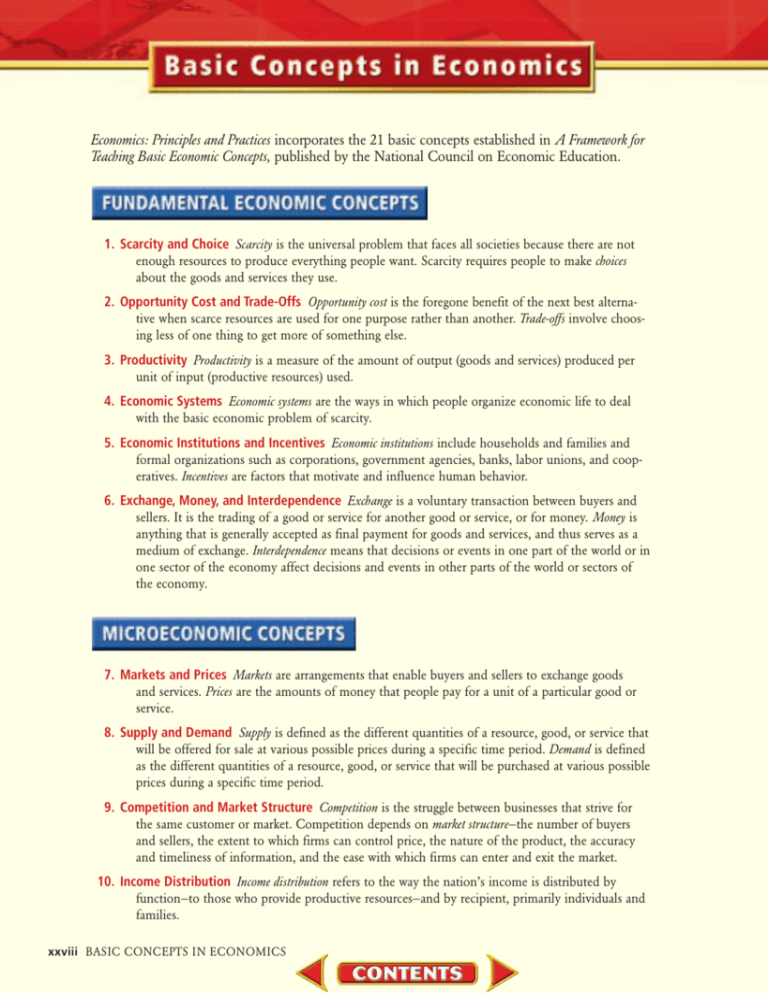Basic Concepts in Economics
advertisement

Economics: Principles and Practices incorporates the 21 basic concepts established in A Framework for Teaching Basic Economic Concepts, published by the National Council on Economic Education. 1. Scarcity and Choice Scarcity is the universal problem that faces all societies because there are not enough resources to produce everything people want. Scarcity requires people to make choices about the goods and services they use. 2. Opportunity Cost and Trade-Offs Opportunity cost is the foregone benefit of the next best alternative when scarce resources are used for one purpose rather than another. Trade-offs involve choosing less of one thing to get more of something else. 3. Productivity Productivity is a measure of the amount of output (goods and services) produced per unit of input (productive resources) used. 4. Economic Systems Economic systems are the ways in which people organize economic life to deal with the basic economic problem of scarcity. 5. Economic Institutions and Incentives Economic institutions include households and families and formal organizations such as corporations, government agencies, banks, labor unions, and cooperatives. Incentives are factors that motivate and influence human behavior. 6. Exchange, Money, and Interdependence Exchange is a voluntary transaction between buyers and sellers. It is the trading of a good or service for another good or service, or for money. Money is anything that is generally accepted as final payment for goods and services, and thus serves as a medium of exchange. Interdependence means that decisions or events in one part of the world or in one sector of the economy affect decisions and events in other parts of the world or sectors of the economy. 7. Markets and Prices Markets are arrangements that enable buyers and sellers to exchange goods and services. Prices are the amounts of money that people pay for a unit of a particular good or service. 8. Supply and Demand Supply is defined as the different quantities of a resource, good, or service that will be offered for sale at various possible prices during a specific time period. Demand is defined as the different quantities of a resource, good, or service that will be purchased at various possible prices during a specific time period. 9. Competition and Market Structure Competition is the struggle between businesses that strive for the same customer or market. Competition depends on market structure—the number of buyers and sellers, the extent to which firms can control price, the nature of the product, the accuracy and timeliness of information, and the ease with which firms can enter and exit the market. 10. Income Distribution Income distribution refers to the way the nation’s income is distributed by function—to those who provide productive resources—and by recipient, primarily individuals and families. xxviii BASIC CONCEPTS IN ECONOMICS 11. Market Failures Market failures occur when there is inadequate competition, lack of access to reliable information, resource immobility, externalities, and the need for public goods. 12. The Role of Government The role of government includes establishing a framework of law and order in which a market economy functions. The government plays a direct and an indirect role in the economy as both a producer and a consumer of goods and services. 13. Gross Domestic Product Gross Domestic Product (GDP) is defined as the market value of the total output of all final goods and services produced within a country’s boundaries during one year. 14. Aggregate Supply and Aggregate Demand Aggregate supply is the total amount of goods and services produced by the economy during a period of time. Aggregate demand is the total amount of spending on goods and services in the economy during a period of time. 15. Unemployment Unemployment is defined as the number of people without jobs who are actively seeking work. This is also expressed as a rate when the number of unemployed is divided by the number of people in the labor force. 16. Inflation and Deflation Inflation is a sustained increase in the average price level of the entire economy. Deflation is a sustained decrease in the average price level of an entire economy. 17. Monetary Policy Monetary policy consists of actions initiated by a nation’s central bank that affect the amount of money available in the economy and its cost (interest rates). 18. Fiscal Policy Fiscal policy consists of changes in taxes, in government expenditures on goods and services, and in transfer payments that are designed to affect the level of aggregate demand in the economy. 19. Absolute and Comparative Advantage and Barriers to Trade Absolute advantage and comparative advantage are concepts that are used to explain why trade takes place. Barriers to trade include tariffs, quotas, import licenses, and cartels. 20. Exchange Rates and the Balance of Payments An exchange rate is the price of one nation’s currency in terms of another nation’s currency. The balance of payments of a country is a statistical accounting that records, for a given period, all payments that the residents, businesses, and governments of one country make to the rest of the world as well as the receipts that they receive from the rest of the world. 21. International Aspects of Growth and Stability International aspects of growth and stability are more important today than in the past because all nations are much more interdependent. BASIC CONCEPTS IN ECONOMICS 1











